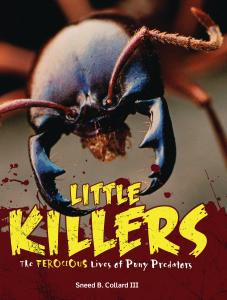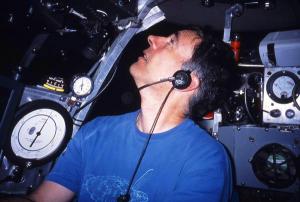
Sneed B. Collard III—Little Killers: The Ferocious Lives of Puny Predators
THE FEROCIOUS LIVES OF PUNY PREDATORS
Sneed B. Collard III
Millbrook Press, March 1, 2022
Hardcover, $31.99, eBook $9.99
Interest Level: Grades 3–6
ISBN-10: 1728415691, ISBN-13: 978-1728415697
ASIN: 1728415691
Collard reports:
I have been fascinated with tiny predators since first looking at a ctenophore, or “comb jelly,” under a microscope in my invertebrate zoology course at UC Berkeley. Not only was the animal astonishingly beautiful, it represented an eat-and-get-eaten world almost totally alien to most people.
For decades the idea to write about ctenophores and other “little killers” simmered in my brain. I felt it unfair that sharks, wolves, and other macro-predators get the, ahem, lion’s share of attention while small predators are every bit as interesting.
One day while talking with Carol Hinz at Millbrook/Lerner, I pitched this topic for a book. Carol seemed interested—and had an open slot on her list—so I wrote a formal proposal. We signed a contract within weeks.
The book’s format allowed room to feature eight different predators. One of my first goals was to select from a wide variety of taxonomic groups, from protozoans and flatworms to spiders and insects. Creating a list proved surprisingly easy since I’d had some experience with most of the organisms and had been waiting to write about them.
To research each subject, I shunned general books and websites and relied almost exclusively on original scientific papers and interviews with scientists. That has always been my preference because it gives a book authenticity and accuracy that you’ll never find elsewhere. I was fortunate to connect with scientists to help me with almost every chapter. I am especially grateful to marine biologist Steven Haddock of the Monterey Bay Research Institute for reading over the entire book.
Working with a new publisher always involves a few growing pains. I had to reorganize some chapters to shape them into a consistent format, but the book turned out better as a result. I was also grateful not to have to round up the book’s photos, leaving that job to Lerner’s excellent staff of photo researchers. I felt especially proud to wrap up with a final chapter on the vital importance of tiny predators, both as useful and harmful species. I hope the book will increase awareness in both young and older readers.
Contact Info:
- Sneed B. Collard III: sbcollardiii@gmail.com, https://www.sneedbcollardiii.com/, Blog: https://fathersonbirding.com/, Facebook: https://www.facebook.com/SneedBCollardIII, Twitter: @sneedcollard; Instagram: @sneedcollard
- Book: https://lernerbooks.com/shop/show/21615
- Publicist: Megan Ciskowski, publicityinfo@lernerbooks.com
NASW members: will your book be published soon? Promote it by submitting your report for Advance Copy.
Tell your fellow NASW members how you came up with the idea for your book, developed a proposal, found an agent and publisher, funded and conducted research, and put the book together. Include what you wish you had known before you began working on your book, or had done differently.
See https://www.nasw.org/advance-copy-submission-guidelines.
View Advance Copy archives at https://www.nasw.org/member-article/advance-copy.
Thinking of writing a book? If you are a NASW member, you may access a list of more than 200 books and online resources to help you craft your book proposal, find an agent and funding sources, negotiate your contract, learn about self-publishing, publicize and market your book, and more at https://www.nasw.org/article/write-book.
Send book info and questions about book publishing to Lynne Lamberg, NASW book editor, llamberg@nasw.org.
Follow @LynneLamberg on Twitter for news about science/medical books, writing, and NASW authors.
Hero photo via NOAA, public domain
Advance Copy
The path from idea to book may take myriad routes. The Advance Copy column, started in 2000 by NASW volunteer book editor Lynne Lamberg, features NASW authors telling the stories behind their books. Authors are asked to report how they got their idea, honed it into a proposal, found an agent and a publisher, funded and conducted their research, and organized their writing process. They also are asked to share what they wish they’d known when they started or would do differently next time, and what advice they can offer aspiring authors. Lamberg edits the authors’ answers to produce the Advance Copy reports.
NASW members: Will your book be published soon? Visit www.nasw.org/advance-copy-submission-guidelines for information on submitting your report.
Publication of NASW author reports in Advance Copy does not constitute NASW's endorsement of any publication or the ideas, values, or material contained within or espoused by authors or their books. We hope this column stimulates productive discussions on important topics now and in the future as both science and societies progress. We welcome your discussion in the comments section below.


